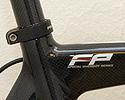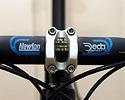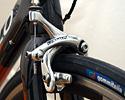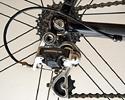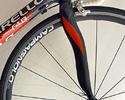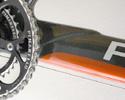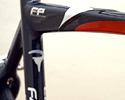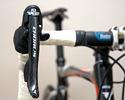
Recently on Cyclingnews.com |
On test: Pinarello F4:13, October 28, 2005
One piece wonder
Pinarello's F4:13 is the company's first foray into carbon fiber monocoque construction and feels like it turns every iota of effort into forward motion, says Chris Henry.
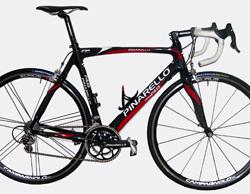
|
Pinarello has been slow to jump aboard the all-carbon juggernaut, preferring to concentrate on its highly-regarded magnesium-frame technology as showcased in the Dogma series of bikes. But the attraction and momentum of carbon is unavoidable, and while the all-carbon F4:13 hasn't displaced the Dogma at the top of Pinarello's line-up, it is clearly a serious and purposeful attempt to use the material's properties to best advantage, starting with one-piece main frame construction to exploit carbon's stiffness and low weight.
A stiff, performance-oriented racer at heart, the F4:13 slots in the mid to upper range of the Pinarello line and proves itself worthy of the position. The shift in design from Pinarello's recent offerings is evident immediately. Big tubes and interesting lines set the F4:13 apart from the traditional stock, not to mention the increased surface area on the downtube for bold Pinarello branding. The frame is currently available in six sizes, with top tube lengths ranging from 51.2cm to 59cm.
First impressions
I initially expected the F4:13 to give me some fit problems. It looks short, and the relatively short 110mm stem and the stubby Campy brake levers created an illusion that I was bunched up on the bike. But when I adjusted the saddle to my usual setback and height, I fit rather well on the bike, solving that end of the equation fairly easily.
Early rides with the F4:13 made me realise too that the handling, while superb, is somehow different than that to which I am accustomed. The 43mm offset of the Pinarello's Onda fork, combined with a 73 degree head angle (for a 55cm frame), makes for very agile steering. Yet the bike doesn't feel too nervous at all. It's as if it reacts with zero hesitation to your slightest nudge, yet doesn't get carried away and steer you off your course or prompt an anxious urge to correct any wobbles.
I found the handling differences revealed themselves most when riding on the drops, out of the saddle (sprinting or just getting that bit of extra power along the way). Part of this was also due to the shape of the Deda Newton bars, with a very steep angle in the 'ergo' bend of the drops. How much of a difference in comfort or handling the Onda rear stays make, I'm not sure, but they look distinctively Pinarello, so that counts for something.
Components
Our F4:13 came equipped with a mix of components. Campagnolo's Chorus group provided the braking and shifting, while the brake calipers were Centaur, not that I noticed any difference there. In fact, the braking was quite powerful yet generally smooth and easy to vary between full-on stops and minor changes in speed on a descent. However, at slow speeds, such as in traffic, the brakes tended to grab somewhat and felt a bit jerky. When rolling under faster, more ideal circumstances, the ability to feather the brakes and moderate speed - or stop on a dime - was more impressive.
Pinarello slapped its name on a Deda stem, paired with Deda's Newton handlebars, and provided a carbon fiber seat post. I stuck with the Selle Italia SLR XP saddle for this test. I'd tested this saddle in the past and knew it to be comfortable for me considering its light weight, although as a fairly short saddle it doesn't offer much room to shift around in different riding situations.
The drivetrain for the F4:13 includes FSA's carbon compact crank (50x34) and a 12-23 cassette in the rear. Campagnolo Eurus clincher wheels keep the bike rolling, paired with Gommitalia Calypso tires.
On the road
The enormous downtube and one-piece design of the F4:13 mean one thing: this bike is stiff! The F4:13 is the type of bike that lets you feel that every ounce of force you put on the pedal is going into making you move. In the saddle, but particularly out, acceleration comes instantly on the bike. Nowhere did I feel this most than on the up and down of short rolling hills, when that extra kick out of the saddle to keep the momentum on the upswing becomes the most fun part of the ride.
The flipside to this, of course, is that the bike does not feel very forgiving. My experience is that, in general, a stiff carbon bike will still be more comfortable than a stiff aluminium bike. Carbon frames and forks generally damp a bit more vibration, while remaining fairly stiff and light. However, of all the test bikes I've had the pleasure to ride in the past few years, this was the most demanding physically. I didn't feel as though I'd been put through the ringer or left jarred by the experience after a ride, but my hands and arms did let me know that they were doing a bit more than usual to soak up the bumps.
For some riders, the extreme stiffness of a bike like the F4:13 outweighs the disadvantage of its slight harshness. Others like a softer ride. Clearly there's a point of preference, but it's worth noting that even a beautifully made carbon bike can rattle the bones a little. Of course this concept is the equivalent of sports suspensions on cars, and this bike leaves nothing on the road, as they say. If you want to ride quickly, and you've got the strength to do it, the F4:13 won't do a thing to get in your way.
For me, the component choices may have played into my perceptions of this bike too. I have a personal preference for Shimano shift levers over Campagnolo, as the softer and more ergonomic shape of Dura-Ace levers is, to my hands, much more comfortable than the Campy equivalent. Campagnolo's levers features a very notable outside edge under the rubber cover that seems to dig into my palm when riding on the hoods, which just happened to be the position I found most natural on this bike.
Furthermore, the Deda Newton stem and handlebar were not quite my cup of tea. I prefer a more shallow drop in the handlebar, and the relatively deep drop of the Newton, combined with the test bike's lower stem height, meant that I spent most of my time on the hoods rather than in a somewhat forced tuck. The bars also felt quite thin in diameter, giving my hands less to wrap themselves around when riding on the tops of the bars. This is another example of personal preference as opposed to a commentary on the quality of Deda's equipment, which has been the choice of numerous professional teams over the years.
I also didn't get on with the 50x34 compact cranks. The trend may be on the rise, as more bikes are sold with compact cranks and more manufacturers take their own crack at the modified design, but personally I'm happy with more conventional front chainrings. I found myself double shifting too much on the rolling terrain, spending more time thinking about how to find the right gear than how to get up the hill at an acceptable pace. The frame didn't slow me down but I'd say the shifting did. Of course there's an adjustment to this set-up as there is for many things, but in the end I never quite got there.
Despite this critique, I did manage to set a personal best on a local 1 mile climb on the F4:13. Maybe because it's a 'find the right gear and go' kind of climb. For that I'll choose to thank the frame and leave the gearing aside.
Overall impressions
All in all, I found the F4:13 to be a superb bike when it comes to pure speed and performance. Typical rides in the 2.5 to 3 hour range featured plenty of modest hills, some fast rolling flats, and enough pothole dodging to give credit to the nice front end handling, once I became accustomed to the Pinarello feel.
A few too many quirks in components, coupled with the super stiff ride of the F4:13, prompt me to give it a four-jersey rating as opposed to anything higher. I loved the frame, but given a choice would have built it up with a different set of components (as any owner can do). There's no doubt this is a solid performer and for a pure racing machine it's a good choice. However, if your riding includes some racing or fast recreational training, but also plenty of long hours in the saddle on less intense rides, this may not be the perfect frame for you.
Objectively speaking, the F4:13 provides pure-bred performance, competitively light weight, and contemporary Italian styling, making it a worthy contender in the battle of the high end racing bikes.
(Pinarello's North American distributor, Gita Sporting Goods, advises: "the F4:13 is sold as a frame and fork, allowing the buyer to spec the bike to his/her personal preference".)
Pros: Incredibly responsive, efficient frame. Fast!
Cons: Compact crank and other components not to my liking.
Cyclingnews Rating: ![]()
Full specification: Pinarello F4:13Frame: Monocoque carbon fiber Crankset: FSA Compact 50x34 |
MSRP: US$2700 for frame, fork, seatpost and integrated headsetWheels: Campagnolo Eurus clincher Handlebars: Deda Newton Seatpost: Pinarello carbon More information: Pinarello (www.pinarello.com), Gita Sporting Goods (www.gitabike.com) |

